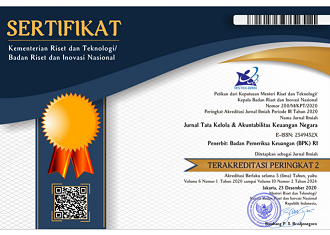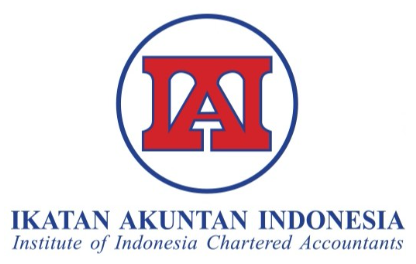ELEMENTS WHICH TRIGGER EMPLOYEE'S INTENTION TO DISCLOSE FRAUD VIA A WHISTLEBLOWING SYSTEM: A CASE STUDY
DOI:
https://doi.org/10.28986/jtaken.v4i2.203Keywords:
Whistleblowing, fraud, employees intentionAbstract
Fraud is very liquid; thus, it could occur both in public sector and private institutions. The consequences of fraud could be very damaging such as the loss of assets and the ruin of a company's reputation. BPK as one of the governmental institutions in Indonesia is obliged to implement a whistleblowing system as a means to detect any fraudulent activities. It is believed that an effective whistleblowing system is likely to be credible and secure so that all employees could disclose misconducts without any hesitation. Therefore, this study aims to contribute to the novelty of the whistleblowing system which has been implemented in BPK. There are several elements to be considered in setting up a whistleblowing system namely, secrecy of the tipsters' identity, incentives, whistleblowers' protection, accessibility, training of ethical program, power owned by the addressee, the perpetrators and the potential whistleblowers, management's support as well as their response to the tips given by the employees. A questionnaire and descriptive statistical analysis are used to rank the elements from the most important to the least essential items in a whistleblowing system from the perspective of the employees in BPK. The result shows that BPK's employees consider the whistleblowers' protection as the most critical element in the system; whereas, rewards is the least factor which triggers them to blow the whistle. Those elements, however, are integral parts which complement each other in establishing an effective whistleblowing mechanism.
References
Apaza, C. R., & Chang, Y. (2011). What makes whistleblowing effective. Pubic Integrity, 13(2), 113-130.
Albrecht, W. S., Albrecht, C. O., Albrecht, C. C., & Zimbelman, M. F. (2014). Fraud examination (5thed.). Cengage Learning United States of America, Boston.
Alleyne, P., Charles-Soverall, W., Broome, T., & Pierce, A. (2017). Perceptions, predictors and consequences of whistleblowing among accounting employees in Barbados. Meditari Accountancy Research, 25(2), 241-267. Retrieved from https://search.proquest.com/ docview/ 1911202010? accountid=86413.
Code of Ethics in BPK Number 3 Year 2016 (Peraturan BPK Nomor 3 Tahun 2016 tentang Kode Etik BPK). Retrieved from https://peraturan.bpk.go.id/ Home/Details/24.
Dasgupta, S., & Kesharwani, A. (2010). Whistleblowing: a survey of literature. IUP Journal of Corporate Governance, 9(4), 57-70. Retrieved from https://search.proquest.com/doc view/759597922?accountid=86413.
Decree of the Secretariat General of the State Audit Board of the Republic of Indonesia Number 507/K/X-XIII.2/ 12/2011 about Whistleblowing in BPK (Keputusan Sekretaris Jenderal Nomor 507/K/X-XIII.2/12/2011 tentang Penanganan pelaporan pelanggaran atau whistleblowing di lingkungan BPK).
Gao, J., Greenberg, R., & Wong-On-Wing, B. (2014). Whistleblowing intentions of lower-level employees: the effect of reporting channel, bystanders, and wrongdoer power status. Journal of Business Ethics, 126(1), 85-99. doi: 10.1007/s10551-013-2008-4.
Indonesia Corruption Watch. (2017). The increase of corruption cases in 2017. Retrieved from: https://antikorupsi. org/id/content/2017-jumlah-kasuskorupsi-menanjak? width=1000&height =700.
Kastiel, K. (2015, October 25). Elements of an effective whistleblower hotline. Retrieved from https://corpgov.law. harvard.edu/2014/10/25/elements-of -an-effective-whistleblower-hotline/.
KPMG. (2012). A survey of fraud, bribery, and corruption in Australia and New Zealand 2012. Australia: Author.
Law of The Republic of Indonesia Number 15 the Year 2006 about the Supreme Audit Board of the Republic of Indonesia (Undang-Undang Republik Indonesia Nomor 15 Tahun 2006 tentang Badan Pemeriksa Keuangan). Retrieved from http://bandung.bpk. go.id/files/2009/03/UU-15-Tahun2006.pdf.
Lee, G., & Fargher, N. (2013). Companies use of whistleblowing to detect fraud: an examination of corporate whistleblowing policies. Journal of Business Ethics, 114(2), 283-295. doi: 10.1007/ s10551-012-1348-9.
Lewis, D., & Trygstad, S. (2009). Protecting the whistleblowers in Norway and the UK: A case of mix and match? International Journal of Law and Management, 51(6), 374-388. doi: 10.1108/17542430911005918.
Lowe, D. J., Pope, K. R., & Samuels, J. A. (2015). An examination of financial sub-certification and timing of fraud discovery on employee whistleblowing reporting intentions. Journal of Business Ethics, 131(4), 757-772. doi: 10.1007/s10551 -013-2020-8.
Parker, C., Le Mire, S., & MacKay, A. (2017). Lawyers, confidentiality, and whistleblowing: lessons from the Mccabe tobacco litigation. Melbourne University Law Review, 40 (3), 999-1056. Retrieved from https://search.proquest.com/doc view/1899315590?accountid= 86413.
Pittroff, E. (2014). Whistleblowing systems and legitimacy theory: A study of the motivation to implement whistleblowing systems in German organizations. Journal of Business Ethics, 124 (3), 399-412. doi: 10.1007/s10551-013 -1880-2.
Presidential Instruction of the Republic of Indonesia Number 2 Year 2014 about Corruption prevention and eradication (Instruksi Presiden Nomor 2 Tahun 2014 tentang Aksi pencegahan dan pemberantasan korupsi). Retrieved from http://www.itjen. depkes.go.id/public/upload/unit/pusat/ files/Inpres%20Nomor%202% 20tahun%202014%20 (2)(1).pdf.
Robinson, S. N., Robertson, J. C., & Curtis, M. B. (2012). The effect of contextual and wrongdoing attributes on organizational employee's whistleblowing intentions following the fraud. Journal of Business Ethics, 106, 213-227. doi: 10.1007/s10551-011-0990-y.
Rose, J. M., Brink, A. G., & Carolyn, S. N. (2018). The effects of compensation structures and monetary rewards on manager's decisions to blow the whistle. Journal of Business Ethics, 150 (3), 853-862. doi: 10.1007/s10551016-3222-7.
Transparency International. (2017). Corruption perceptions index 2017. Retrieved from https:// www.transparency.org/news/feature/ corruption_perceptions_index_2017.
Trading Economics. (2018). Indonesia corruption index 1995-2018. Retrieved from https://tradingeconomics.com/ Indonesia/corruption-index.
World Bank. (June 2017). World Bank list of economies (June 2017). Retrieved from http://iccmoot.com/wpcontent/uploads/2017/07/WorldBank-List-of-Economies.pdf.
Yeoh, P. (2014). Whistleblowing: Motivations, corporate self-regulation, and the law. International Journal of Law and Management, 56 (6), 459-474. Retrieved from https:// search.proquest.com/docview/ 1650884799?accountid=86413
Downloads
Submitted
Accepted
Published
How to Cite
Issue
Section
License

Jurnal Tata Kelola dan Akuntabilitas Keuangan Negara is licensed under
a Creative Commons Attribution-ShareAlike 4.0 International License




















